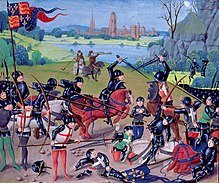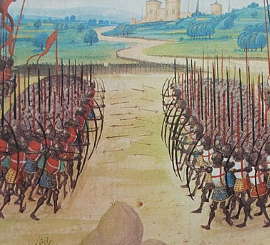Summary of the Hundred Years’ War (1337-1453)

Hundred Years’ War summary
The Hundred Years’ War was in fact a 116-year long fierce struggle between the Kingdom of England and the Kingdom of France. The struggle hovered around succession to the French throne.
Lasting from 1337 to 1453, the war begins with English forces, under the leadership of King Edward III, having the upper hand in terms of determination and focus. As the war progressed, battle victories would move back and forth between the two nations. Some of the greatest highlights of the war came during the reign King Henry V of England, who in 1415 secured a famous victory over French force at the Battle of Agincourt.
And just as the French throne appeared to be in the grasp of the English monarch, Henry V passed away in 1422. From that period onward, French forces would gather an enormous amount of confidence and bravery to go on the offensive. Charles VII of France and his troops drew immense inspiration from the teenage peasant girl Jeanne d’Arc (Joan of Arc) to take back the territories previously lost to England.
In the article below, WHE provides a quick summary of the major events and battles that happened in the Hundred Years’ War.
The two major claimants to the French throne
Following the death of Charles IV of France on February 1, 1328, the English royal house of Plantagenet and the French royal House of Valois locked horns over the throne of France. Charles had died without a male heir. On the English side was King Edward III, son of Charles IV’s sister Isabella. On the French side was Philip VI, first cousin of Charles IV.
For many decades before the onset of the Hundred Years’ War, England and France had been at loggerheads on so many issues. Sometimes those tensions spiraled into skirmishes and battles between those two European kingdoms. However, those tensions entered a new stratosphere when Edward III, son of Edward II of England and Isabella of France, laid claim to the throne of France. Edward III started making those claims around 1327, citing his parents’ lineage to France’s line of succession. Edward argued that because his mother, Queen Isabella of England was the sister of Charles IV of France, he was the rightful heir to the throne of France.
Philip VI seizes the Duchy of Aquitaine from Edward III

French nobles and assemble of French barons vehemently rejected Edward III’s claim. To the French nobility, Isabella did not have the rights in the first place as women could not become rulers of France. Hence Isabella could not transfer something she did not own in the first place.
The succession crisis reached new heights when Philip VI, first cousin of Charles IV, laid claimed to the French crown. Although Edward III was Charles IV’s closest male relative, the Estates General in France ruled in favor of Philip VI, citing the rule that women could not become monarchs of France. With enough backing from French barons and prelates, Philip VI inherited the throne.
Initially the relationship between Philip VI and Edward III was quite an amicable one; however all of that changed when Philip VI began supporting David II of Scotland. Edward responded by granting his support to Robert III of Artois, a staunch enemy of Philip. Edward’s refusal to extradite Robert to France caused Philip to seize the Duchy of Aquitaine; the French king cited reasons on disobedience and disloyalty in 1337.
Edward III fights back

With enough support, Philip, Count of Valois, was crowned king of France at the Cathedral of Reims on May 29, 1328. Philip was the patrillineal cousin of Charles IV of France. After a few protests, Edward reluctantly accepted Philip’s ascension to the throne. In June 1329, he obliged with a summon from Philip to pay homage for the duchy of Aquitaine and Guscony. As stated earlier, those territories were the property of the English monarch. | Image: King Edward III of England as he was depicted in the late 16th century
And so the Hundred Years’ War began with Edward III fighting Philip VI to take back Aquitaine and also reassert his claim to the French crown. As tensions heated up, the conflict would encompass so many other issues, including share of the wool trade in Europe, territorial disputes, and most importantly France’s continued support for Scotland, who at the time was a niggling nuisance to Edward III.
As France was way more populous and richer than England, Edward III’s goal was not seize or take complete control of France. Edward began by raiding and destroying all the infrastructure in French territories. The term used to describe those raids was chevauchée. Edward’s plundering tactics was somewhat similar to the modern warfare strategy of scorched earth. In any case, those strategies by Edward did cause considerable amount of pain to the Philip VI.
Charles V of France takes back seized French lands from the English
Right of the bat, England appeared to be the more determined of the two countries. The English monarchs enjoyed a period of very successful battle wins, including the ones at Crécy in 1346 and Poitiers in 1356. However, France, then under the leadership of Charles V, the grandson of Philip VI, gathered itself and came roaring as it retook those lost territories from English hands. A period of relative peace reigned for a while following Richard II of England’s marriage to Isabella of Valois, one of the daughters of Charles VI of France.
England’s famous win at the Battle of Agincourt

15th century miniature depicting the Battle of Agincourt of 1415
Upon the death of Richard in 1400, tensions blew into a never-before-seen proportion. This time around, England was again in the ascendancy and soon a famous victory at the Battle of Agincourt in 1415 was secured by Henry V of England. His opponent, the mentally unstable Charles VI of France, sued for peace and made Henry V of England his heir. As part of the Treaty of Troyes in 1420, Henry married Catherine de Valois, the daughter of Charles VII, and became regent and heir to the throne of France.
France roars its way to several important victories
Henry’s death before Charles’ meant that he never got the chance to be crowned king of France. Per the peace treaty of 1420, Henry V’s infant son was supposed to inherit the thrones of England and France. However, Charles VI’s son Charles VII went ahead to crown himself king of France on July 17, 1429 at Reims Cathedral. His French army had wind in their sails kind courtesy to the boost they received from Joan of Arc, a French peasant who believed visions from God told her to renew the French nation under Charles VII. The new French monarch was able to break the English-Burgundian alliance and then proceed to bring Paris under his control in 1436. Charles continued his push back, reconquering Normandy in the 1440s.

Coronation of Charles VII at Reims Cathedral, in the presence of Joan of Arc and armoured men-at-arms (15th century).
In the end, France, with the help of the French peasant Joan of Arc, was able to turn the tides and successfully drive out English forces from France except Calais. By 1453, the two countries had gradually gravitated into an uneasy period of peace as both monarchies would thereafter remain separate.
More Hundred Years’ War Facts

Battle of Sluys in 1340 | Image from a BNF manuscript of Froissart’s Chronicles, Bruges, c. 1470.
Historians often place the war into three main periods – the Edwardian War (1337-1360), the Caroline War (1369-1389), and the Lancastrian War (1415-1453).
The collective effect of those phases had monumental impact on the history of all of Europe. During that period, the Black Death, which ravaged through Europe and claimed the lives of a significant percentage of the population, came and went; innovations were made in military armor and strategy, which revolutionized warfare in Europe; and finally, there was a rise in nationalism across Europe, particularly in those two countries.
One such military advancement during the war came in the form of the English longbow, which was used to devastating impact as it allowed English forces to release their arrows faster and farther than what the French crossbows could do.
The Hundred Years’ War basically pitted the English royal House of Plantagenet, led by Edward III, against the French royal House of Valois, led by Philip VI. As it lasted in phases for a whopping 116 years, the Hundred Years’ War was one the most notable events in Medieval Europe. To put into perspective just how long the war stretched, one needs to bear in mind that the war required total of five generations of kings from both England and France to wrestle for the throne of France.


























